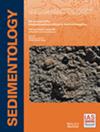半流体沉积物中脊椎动物足迹的形成与保存:潮滩和实验室实验的启示
IF 2.8
2区 地球科学
Q1 GEOLOGY
引用次数: 0
摘要
尽管脊椎动物足迹提供了宝贵的古生态学和古环境信息,但在半液态沉积物中形成的足迹却在很大程度上被忽视了,因为人们认为它们是作为大量破碎的沉积物保存下来的,而且保存潜力较低。然而,了解它们的形成、填充和保存机制至关重要,因为它们在化石记录中的数量可能比预期的要多,或者会被误解为其他软沉积变形结构。为了解决这些问题,本研究分析了在法国西北部圣米歇尔山海湾潮间带上部的半液态沉积物中,沿着一只脚留下的人类足迹所做的连续横断面,并对其进行了监测,直至其完全埋藏。这些数据与在水槽中制作的足迹横截面进行了比较。横截面显示,与这些足迹相关的沉积结构反映了足迹的形成和填充机制,甚至反映了脚步的动态。这些结构包括:(i) 脚踏入时在轨迹两侧形成的边缘;(ii) 脚踏出时产生的向上变形结构;(iii) 同步轨迹填充,即在脚踏出时几乎完全填满轨迹,由轨迹壁上塌陷的沉积物或液化的沉积物形成;(iv) 后轨迹填充,即在随后的水淹过程中完全填满轨迹。这项工作表明,在潮汐环境中,这些轨道具有很高的保存潜力,特别是如果它们是在春潮高峰期之后形成的,并且在潮汐退去时经历了干燥和固结,这就防止了它们的侵蚀,有利于它们被沉积物掩埋。在同类化石中识别上述结构可提供有用的古环境信息,因为这些结构可将这些足迹与含水量较低的沉积物中的足迹以及与它们非常相似的其他软沉积物变形结构(即卷曲垫层和球枕)区分开来。本文章由计算机程序翻译,如有差异,请以英文原文为准。
Formation and preservation of vertebrate tracks in semi‐liquid sediments: Insights from tidal flats and laboratory experiments
Despite the valuable palaeoecological and palaeoenvironmental information provided by vertebrate tracks, those made in semi‐liquid sediments have been largely overlooked because they are assumed to be preserved as a mass of disrupted sediment and to have a low preservation potential. Nevertheless, understanding their mechanisms of formation, infilling and preservation is crucial since they could be more abundant in the fossil record than expected or be misinterpreted as other soft‐sediment deformation structures. To solve these aspects, this study analyses consecutive cross‐sections performed along a human track made by a shod foot in semi‐liquid sediments in the upper intertidal flats of the Bay of Mont‐Saint‐Michel (north‐west France) and monitored until its complete burial. These were compared with cross‐sections of tracks made in a flume tank. Cross‐sections reveal that the sediment structures associated with these tracks reflect the mechanism of their formation and infilling, and even the footstep dynamics. These structures comprise: (i) marginal rims that developed at both sides of tracks during foot penetration; (ii) upward deformation structures produced during foot withdrawal; (iii) a syn‐track infilling , which almost entirely fills the tracks during the withdrawal, formed by sediment collapsed from the track walls or by liquefied sediment; (iv) a post‐track infilling that fills the tracks completely during their subsequent flooding. This work demonstrates that these tracks have a high preservation potential in tidal settings, especially if they are made after the peak of a spring tide period, and undergo desiccation and consolidation during neap tides, which prevents their erosion and favours their burial by sediment. The identification of the above‐mentioned structures in fossil counterparts provides useful palaeoenvironmental information, because they allow discriminating these tracks from those made in sediments with less water content and from other soft‐sediment deformation structures (i.e. convolute bedding and balls‐and pillows) with which they share strong resemblances.
求助全文
通过发布文献求助,成功后即可免费获取论文全文。
去求助
来源期刊

Sedimentology
地学-地质学
CiteScore
8.20
自引率
11.40%
发文量
94
审稿时长
6-12 weeks
期刊介绍:
The international leader in its field, Sedimentology publishes ground-breaking research from across the spectrum of sedimentology, sedimentary geology and sedimentary geochemistry.
Areas covered include: experimental and theoretical grain transport; sediment fluxes; modern and ancient sedimentary environments; sequence stratigraphy sediment-organism interaction; palaeosoils; diagenesis; stable isotope geochemistry; environmental sedimentology
 求助内容:
求助内容: 应助结果提醒方式:
应助结果提醒方式:


